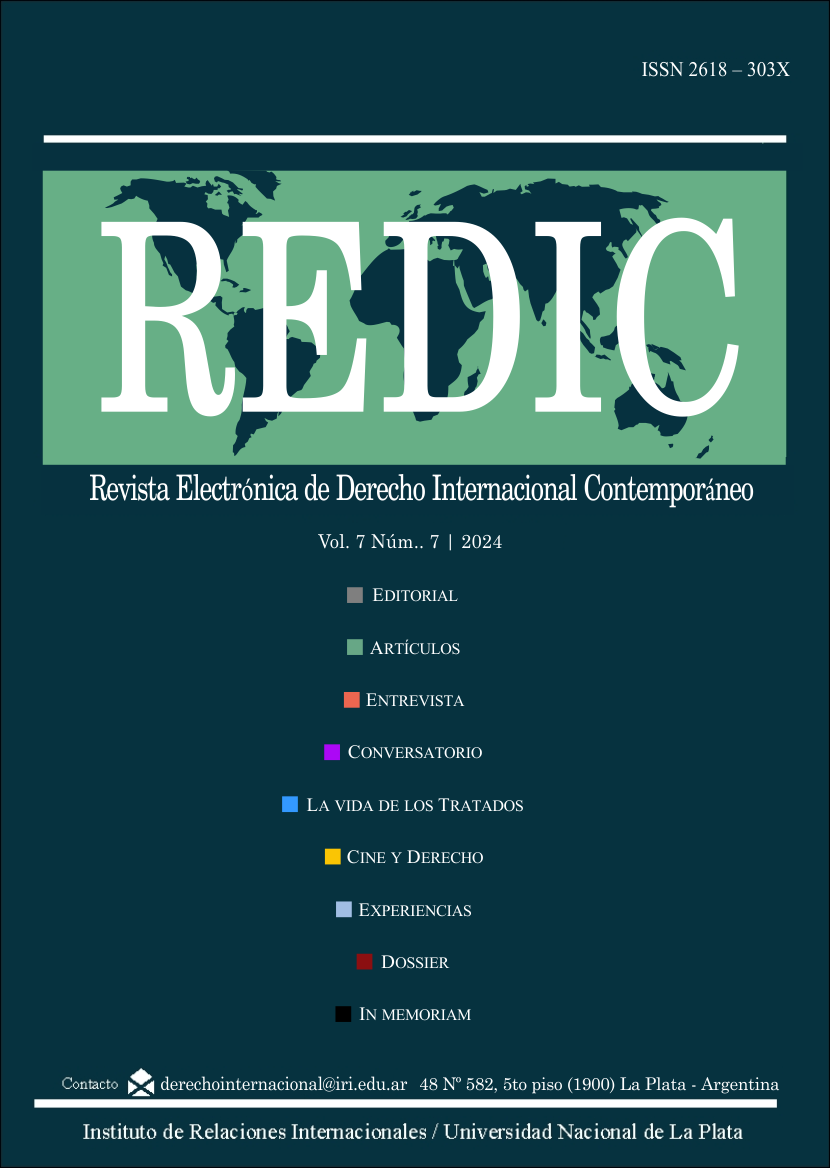An approach to gender stereotypes in the depiction of female genital mutilation in the movies
An analysis of “Flower of the Desert”
DOI:
https://doi.org/10.24215/2618303Xe066Keywords:
sexual violence, international protection system, gender-based discrimination, patriarchal systemAbstract
This article tackles the study of gender stereotypes as found in female genital mutilation practices, based on the perspectives put forward by the international prohibition of discrimination against women and girls. Our analysis focuses on the film entitled “Flower of the Desert”, which centers around Waris Dirie, UN special ambassador (1997-2003) against the mutilation of female genitalia. By looking at her personal and professional path in her struggle to defend girls and women's rights around the world, we will explore the impact that the patriarchal system has on women's bodies and we will dive deep into the nature of this form of sexual violence.
Downloads
References
Al Jazeera Correspondent. (24 de abril de 2018). The Cut: Exploring FGM. https://www.aljazeera.com/program/al-jazeera-correspondent/2018/4/24/the-cut-exploring-fgm
Canal Cero. (24 de marzo de 2018). Aislamiento, parir acostada y “un punto más para el marido”: 10 expresiones de violencia obstétrica en Chile. El Desconcierto. https://eldesconcierto.cl/2018/03/24/aislamiento-parir-acostada-y-un-punto-mas-para-el-marido-diez-expresiones-de-violencia-obstetrica-en-chile
Clérico, L. (2018). Hacia un análisis integral de estereotipos: desafiando la garantía estándar de imparcialidad. Revista Derecho del Estado, 41, 67-96. https://doi.org/10.18601/01229893.n41.03
Cook, R. J. y Cusack, S. (1997). Estereotipos de género: Perspectivas legales transnacionales. Profamilia.
Cosoy, N. (14 de julio de 2016). “Cortó con una tijerita el clítoris de la bebé y le empezó a salir un chorro de sangre”: el silencioso problema de la mutilación genital femenina en Colombia. BBC Mundo. https://www.bbc.com/mundo/noticias-america-latina-36727805
Crenshaw, K. (1991). Mapping the Margins: Intersectionality, Identity Politics, and Violence against Women of Color. Stanford Law Review, 43(6), 1241-1299. https://doi.org/10.2307/1229039
Diawara, F. (19 de noviembre de 2023). Sete. Features Brooklyn Youth Chorus [Video]. YouTube. https://youtu.be/-ARK9pKhMTQ?si=2xj8rCHb4W72h4ZI
Esho, T., Kimani, S., Nyamongo, I., Kimani, V., Muniu, S., Kigondu, C., Ndavi, P. y Guyo, J. (2017). The 'heat' goes away: sexual disorders of married women with female genital mutilation/cutting in Kenya. Reproductive Health, 14(1), 164. https://doi.org/10.1186/s12978-017-0433-z
Eyumeneh, N. O. (2022). Breast ironing, a silent case of violence against girls in Cameroon. República y Derecho, 8(8), 1-35. https://doi.org/10.48162/rev.100.003
Fondo de Población de las Naciones Unidas. (2020). Preguntas frecuentes sobre la mutilación genital femenina. https://www.unfpa.org/es/resources/preguntas-frecuentes-sobre-la-mutilacion-genital-femenina-mgf
Newton, R. J. y Glover, J. (2022). “I Can’t Blame Mum”: A qualitative exploration of relational dynamics in women with female genital mutilation (FGM) in the United Kingdom. Violence Against Women, 28(1), 3-25. https://doi.org/10.1177/1077801221994913
Rahman, A. y Toubia, N. (Eds.). (2000). Female genital mutilation: a guide to laws and policies worldwide. Zed books.
UN News. (8 de marzo de 2024). Over 230 million women and girls subjected to female genital mutilation: UNICEF. https://news.un.org/en/story/2024/03/1147402
UN Women. (4 de febrero de 2019). El testimonio de las sobrevivientes: mujeres que lideran el movimiento para poner fin a la mutilación genital femenina. https://www.unwomen.org/es/news/stories/2019/2/compilation-women-leading-the-movement-to-end-female-genital-mutilation
Walby, S., Towers, J., Balderston, S., Corradi, C., Francis, B., Heiskanen, M., Helweg-Larsen, K., Mergaert, L., Olive, P., Palmer, E., Stöckl, H. y Strid, S. (2017). Different forms of violence. En The concept and measurement of violence (pp. 57-102). Bristol University Press. http://www.jstor.org/stable/j.ctv47w5j0.9
World Health Organization. (5 de febrero de 2024). Fact Sheet. Female Genital Mutilation. https://www.who.int/es/news-room/fact-sheets/detail/female-genital-mutilation
World Health Organization. (2008). Eliminating female genital mutilation: An interagency statement. OHCHR, UNAIDS, UNDP, UNECA, UNESCO, UNFPA, UNHCR, UNICEF, UNIFEM, WHO. https://www.who.int/publications/i/item/9789241596442
Additional Files
Published
How to Cite
Issue
Section
License
Copyright (c) 2024 Mayra A. Scaramutti

This work is licensed under a Creative Commons Attribution-NonCommercial-ShareAlike 4.0 International License.
Aquellos autores/as que tengan publicaciones con esta revista, aceptan los términos siguientes:
- Los autores/as conservarán sus derechos de autor y garantizarán a la revista el derecho de primera publicación de su obra, el cuál estará simultáneamente sujeto a la Licencia de reconocimiento de Creative Commons (BY-NC-SA) 4.0 que permite a terceros compartir la obra siempre que se indique su autor y su primera publicación esta revista, no se haga uso comercial, y si se remezcla, se transforma o se crea a partir del material, se debe distribuir bajo la misma licencia del original.
- Los autores/as podrán adoptar otros acuerdos de licencia no exclusiva de distribución de la versión de la obra publicada (p. ej.: depositarla en un archivo telemático institucional o publicarla en un volumen monográfico) siempre que se indique la publicación inicial en esta revista.
- Se permite y recomienda a los autores/as difundir su obra a través de Internet (p. ej.: en archivos telemáticos institucionales o en su página web) antes y durante el proceso de envío, lo cual puede producir intercambios interesantes y aumentar las citas de la obra publicada. (Véase El efecto del acceso abierto).





















